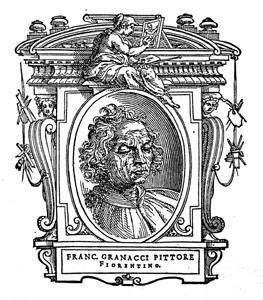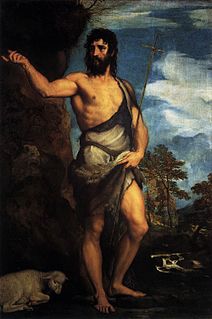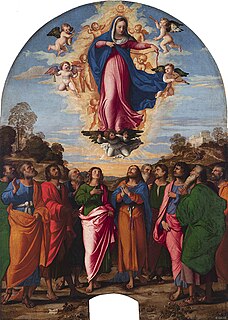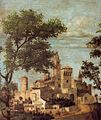
Vittore Carpaccio was an Italian painter of the Venetian school, who studied under Gentile Bellini. He is best known for a cycle of nine paintings, The Legend of Saint Ursula. His style was somewhat conservative, showing little influence from the Humanist trends that transformed Italian Renaissance painting during his lifetime. He was influenced by the style of Antonello da Messina and Early Netherlandish art. For this reason, and also because so much of his best work remains in Venice, his art has been rather neglected by comparison with other Venetian contemporaries, such as Giovanni Bellini or Giorgione.

BartolomeoMontagna was an Italian Renaissance painter who mainly worked in Vicenza. He also produced works in Venice, Verona, and Padua. He is most famous for his many Madonnas and his works are known for their soft figures and depiction of eccentric marble architecture. He is considered to be heavily influenced by Giovanni Bellini, in whose workshop he might have worked around 1470. Benedetto Montagna, a productive engraver, was his son and pupil and active until about 1540. He was mentioned in Vasari's Lives as a student of Andrea Mantegna but this is widely contested by art historians.

The Gallerie dell'Accademia is a museum gallery of pre-19th-century art in Venice, northern Italy. It is housed in the Scuola della Carità on the south bank of the Grand Canal, within the sestiere of Dorsoduro. It was originally the gallery of the Accademia di Belle Arti di Venezia, the art academy of Venice, from which it became independent in 1879, and for which the Ponte dell'Accademia and the Accademia boat landing station for the vaporetto water bus are named. The two institutions remained in the same building until 2004, when the art school moved to the Ospedale degli Incurabili.

Giovanni Battista Cima, also called Cima da Conegliano, was an Italian Renaissance painter, who mostly worked in Venice. He can be considered part of the Venetian school, though he was also influenced by Antonello da Messina, in the emphasis he gives to landscape backgrounds and the tranquil atmosphere of his works. Once formed his style did not change greatly. He mostly painted religious subjects, often on a small scale for homes rather than churches, but also a few, mostly small, mythological ones.

Francesco Granacci was an Italian Renaissance painter active primarily in his native Florence. Though little-known today, he was regarded in his time and is featured in Giorgio Vasari's Lives of the Artists.

Francesco Vecellio was an Italian painter of the early Renaissance, best known as the elder brother of the painter Titian. In his youth, he was a soldier. As a painter, he was mainly active in 1520-1530s in Cadore. In 1524, he signed an altarpiece for San Vito in Cadore. In 1540s, he painted a polyptych at Candide. In late 1540s he painted the organ shutters of San Salvatore in Venice. He painted an Annunciation for San Nicola di Bari, now in the Gallerie dell'Accademia, along with Madonna and Child with Saint Jerome and Saint Dorothy (Glasgow).

The Madonna dell'Orto is a church in Venice, Italy, in the sestiere of Cannaregio.
Giovanni d'Alemagna was a Venetian renaissance painter of German ancestry, active in Italy, with his brother-in-law Antonio Vivarini on religious paintings in Venice and Padua, that are preserved in the named cities together with those of Vivarini.

Giovanni Agostino da Lodi was an Italian painter who was active from c. 1495 to c. 1525.

Saint John the Baptist is a c. 1540 painting of John the Baptist by Titian, with his traditional attributes of the Lamb of God and a staff. It is part of the collection of the Gallerie dell'Accademia of Venice, Italy.

The Madonna of the Small Trees is an oil on panel painting by Italian Renaissance artist Giovanni Bellini, executed in 1487. It is housed in the Gallerie dell'Accademia in Venice.

Enthroned Madonna Adoring the Sleeping Christ Child is a 1475 tempera on panel painting by Giovanni Bellini, now in the Gallerie dell'Accademia in Venice, which acquired it in 1812.

The Madonna and Child with St. John the Baptist and a Female Saint or the Giovanelli Sacred Conversation is an oil painting on panel by Giovanni Bellini, dated to before 1504. It is kept in the Gallerie dell'Accademia of Venice.

The Triptych of the Madonna is a 1464–1470 tempera on panel altarpiece by Giovanni Bellini and others. Its central panel of a standing Madonna and Child measures 127 by 48 cm, its lunette of the Man of Sorrows flanked by angels 59 by 170 cm and its side panels of Jerome and Louis of Toulouse 103 by 45 cm. It is now in the Gallerie dell'Accademia in Venice.

The Pinacotecta Nazionale is an art gallery in Ferrara, Emilia-Romagna, Italy. It is located on the piano nobile of the Palazzo dei Diamanti, a work of Renaissance architecture by Biagio Rossetti, commissioned by Leonello d’Este in 1447. Not to be confused with the Civic Museum on the lower floor, which has hosted temporary exhibitions of contemporary art since 1992, the Pinacoteca houses a collection of paintings by the Ferrarese School dating from the thirteenth to the eighteenth centuries. It was founded in 1836 by the Municipality of Ferrara after Napoleon's widespread dissolution of churches threatened the protection of important public artworks. The gallery is formed as much around notable northern Italian painters as it is around the exquisite interior decoration of the palace itself, together with remnants of frescoes from local churches and later acquisitions from the Sacrati Strozzi collection.

The Assumption of the Virgin is an oil on panel painting by Palma Vecchio, created c. 1513, now in the Gallerie dell'Accademia in Venice.

Storm at Sea or Saints Mark, George and Nicholas Freeing Venice from Demons is a c. 1528 oil on canvas painting by Palma Vecchio, now in the Gallerie dell'Accademia in Venice. It was partly completed in 1535 by Paris Bordon after Palma's death.


















